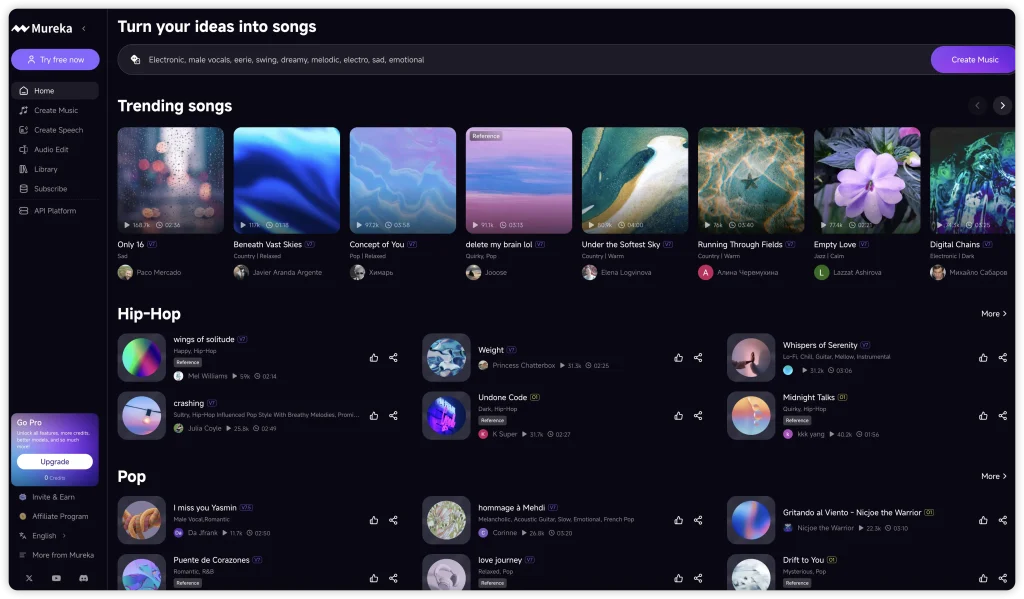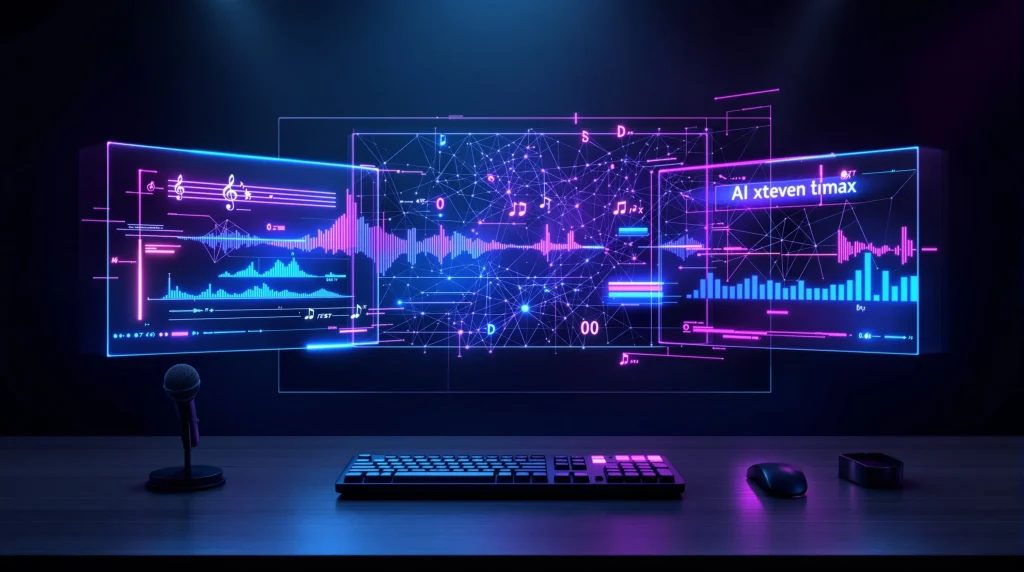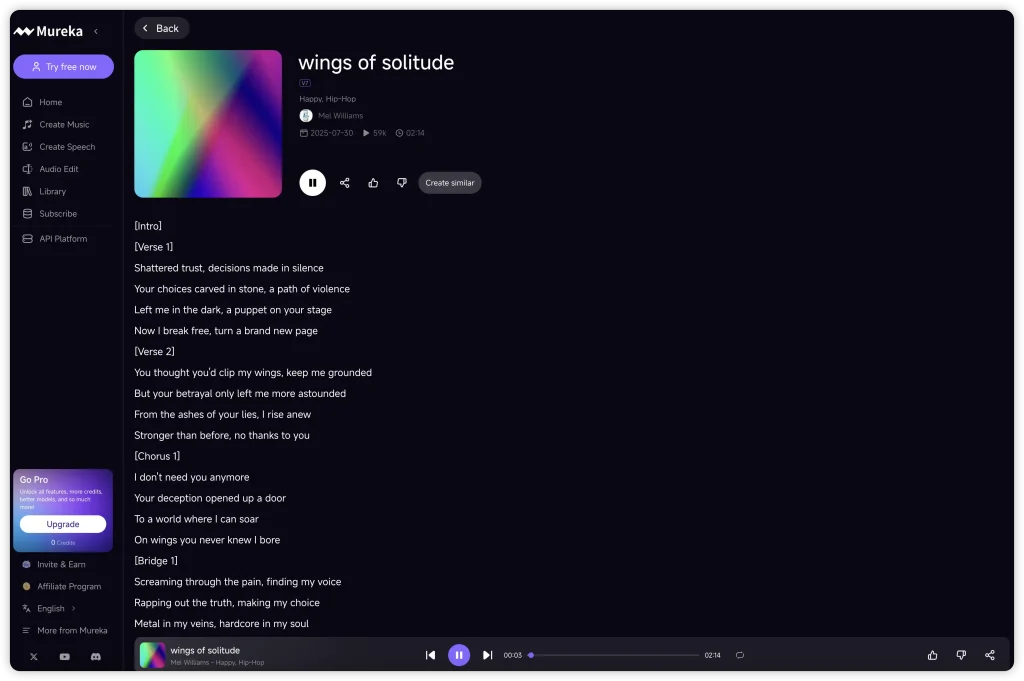
수년간 기술과 크리에이티브 콘텐츠의 교차점을 탐색해 온 사람으로서 저는 제너레이티브 AI가 놀라운 속도로 발전하는 것을 지켜봐 왔습니다. GPT-4로 텍스트를 마스터하고, Midjourney로 시각 예술을 정복했으며, 이제는 가장 복잡하고 감정을 울리는 인간의 표현 중 하나인 음악에 도전하고 있습니다. 정적인 이미지 생성에서 일관성 있고 구조화된 감동적인 노래 작곡으로의 도약은 기념비적인 일입니다.
이 글은 이 급성장하는 분야에서 빠르게 주목받고 있는 플랫폼인 Mureka.ai에 대한 종합적이고 실제적인 리뷰입니다. 저는 상당한 시간을 들여 기능을 테스트하고, 결과를 분석하고, 업계 데이터 및 사용자 피드백과 성능을 상호 참조했습니다. 저의 목표는 콘텐츠 제작자, 전문 음악가, 마케터, 또는 AI에 대해 궁금해하는 모든 분들이 Mureka의 진정한 기능, 현재의 한계, 경쟁이 치열한 AI 음악 환경에서의 위치를 이해하는 데 도움이 되도록 명확하고 편견 없는 평가를 제공하는 것입니다.
핵심 기능을 살펴보고, 음악 제작 과정을 단계별로 살펴보고, Suno 및 Udio와 같은 경쟁사와의 비교를 통해 음악 제작뿐만 아니라 수익 창출까지 가능한 잠재력에 대해 함께 논의해 보겠습니다. 지금 바로 시작하겠습니다.
Mureka.ai란 무엇인가요? AI 작곡 파트너 초보자 가이드
Mureka.ai의 핵심은 다음과 같습니다. AI 기반 음악 생성 는 텍스트, 가사, 흥얼거리는 멜로디 등 사용자의 간단한 입력을 스튜디오 수준의 완성도 높은 노래로 변환하도록 설계된 플랫폼입니다. “음악'과 ”유레카'의 합성어인 이름 자체가 기술을 통해 사용자가 음악적 발견의 순간을 경험할 수 있도록 지원한다는 사명을 완벽하게 담고 있습니다. 사운드 스페이스. 이 플랫폼의 목표는 음악 창작을 민주화하여 기술적 배경이나 음악적 훈련에 관계없이 모든 사람이 음악에 접근할 수 있도록 하는 것입니다. .
단순히 취미로 사용하는 도구가 아닙니다. 제 분석에 따르면 Mureka는 다양한 사용자를 위해 만들어졌습니다:
- 콘텐츠 크리에이터: 저작권 침해 없이 로열티가 없는 고유한 배경 음악이 필요한 유튜버, 팟캐스터, 소셜 미디어 관리자에게 적합합니다.
- 뮤지션 및 작곡가: 프로와 아마추어를 불현듯 떠오르는 영감, 곡 아이디어를 빠르게 프로토타입으로 만들 수 있는 도구, 서정적이거나 멜로디적인 콘셉트를 중심으로 편곡을 구축하는 방법을 찾고 있는 분들을 위한 도구입니다.
- 마케터 및 광고주: 촉박한 기한과 예산으로 브랜드에 맞는 맞춤형 캠페인 트랙을 만들어야 하는 팀.
- 개발자: Mureka는 API를 통해 게임, 앱 및 기타 디지털 경험에 음악 생성을 통합하고자 하는 개발자를 대상으로 합니다.
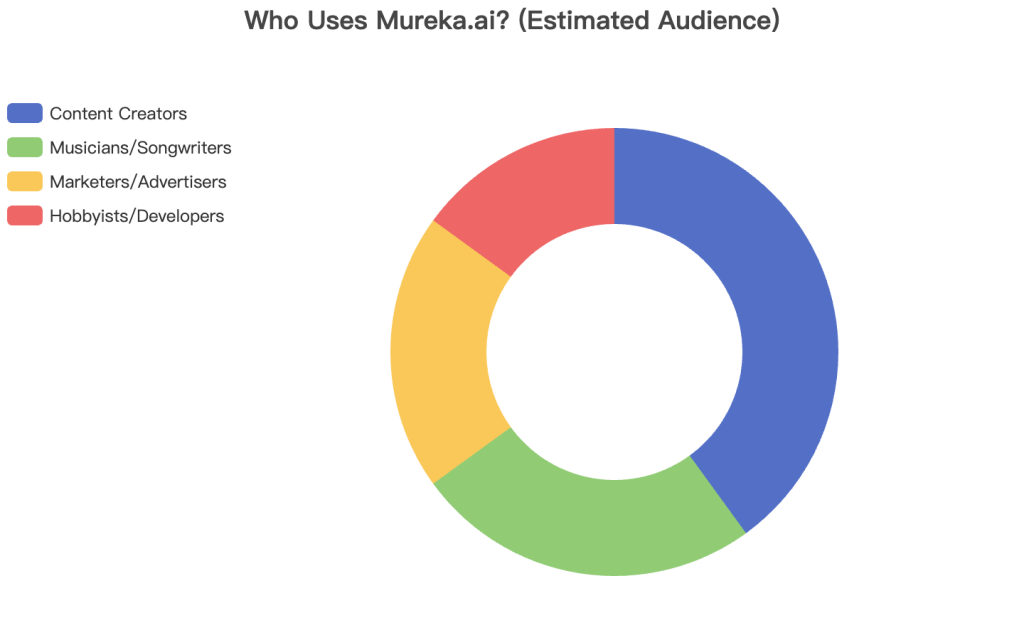
데이터 소스: 예시 데이터 기준 그랜드 뷰 연구 시장 분석.
내부적으로 Mureka는 독자적으로 개발한 정교한 머신 러닝 모델을 기반으로 합니다. 2024년 모회사인 Skywork AI가 출시한 소비자 제품은 빠른 발전을 거듭하여 2025년 7월에 출시된 V7.5 모델에서 정점을 찍었습니다. . 트랜스포머와 같은 기술을 포함하는 이러한 모델은 방대한 음악 작곡 데이터 세트를 학습합니다. 이를 통해 AI는 구조, 화성, 리듬, 감정 톤과 같은 복잡한 음악적 요소를 이해하고 복제할 수 있어 단순한 루프 기반 제너레이터와 차별화됩니다.
2025년 10월까지 이 플랫폼은 이미 전 세계적으로 약 천만 명의 사용자를 유치했으며, “뮤직 에이전트 스튜디오'를 공개하여 보다 직관적인 에이전트 기반 제작 워크플로우로의 전략적 전환을 알렸습니다. . 이러한 빠른 성장과 기술 발전으로 Mureka는 AI 음악 분야에서 중요한 플레이어로 자리매김했습니다.
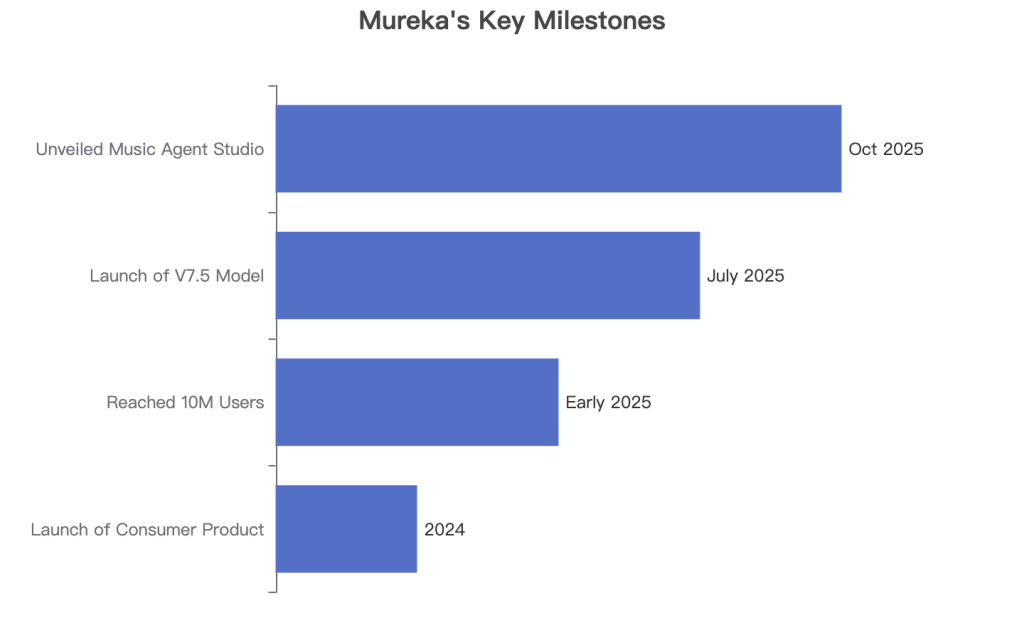
데이터 출처: Mureka의 타겟 고객 분석에 기반한 예상 분석.
데이터 소스: Mureka API 문서, 야후 파이낸스, 비즈니스 인사이더.
Mureka의 주요 기능과 경쟁사 비교: 정면 대결 분석
도구는 그 기능만큼 좋은 것입니다. 테스트 결과, Mureka.ai는 초보자와 고급 사용자 모두를 만족시킬 수 있는 매력적인 기능을 제공했습니다. 하지만 경쟁이 치열한 시장의 맥락에서 이러한 기능을 배치하는 것이 중요합니다.
무레카의 핵심 역량
- 멀티 모달 입력: 바로 이 점이 Mureka가 돋보이는 부분입니다. 텍스트에만 국한되지 않습니다. 가사, 간단한 텍스트 프롬프트, 마이크에 대고 멜로디를 흥얼거리거나 가장 인상적인 것은 특정 분위기를 포착하기 위해 레퍼런스 트랙이나 YouTube 링크를 업로드하여 노래를 생성할 수 있었습니다. AI는 레퍼런스를 복사하는 것이 아니라 그 구성 요소(리듬, 분위기, 악기)를 분석하여 완전히 새로운 것을 만들어 냅니다.
- 고급 사용자 지정 및 편집: 이 플랫폼은 “블랙박스” 생성기 이상의 기능을 제공합니다. 고급 편집기를 사용하면 다음과 같은 태그를 사용하여 노래를 구성할 수 있습니다.
[구절]그리고[코러스], 를 사용하여 착지되지 않은 특정 라인을 재생성하고 섹션을 확장할 수 있습니다. 스템(보컬, 드럼, 베이스 등을 위한 별도의 트랙)을 내보낼 수 있는 기능은 Ableton이나 Logic Pro 같은 디지털 오디오 워크스테이션(DAW)에서 최종 믹싱을 하고자 하는 저 같은 프로듀서에게 획기적인 기능입니다. - 보컬 통합 및 복제: 무레카는 강력한 보컬 도구를 제공합니다. AI 보컬로 트랙을 생성하거나 나만의 스니펫을 업로드할 수 있습니다. 음성 복제 기능은 유료 플랜이 필요하지만 고도의 개인화가 가능합니다.
- 수익 창출 마켓플레이스가 내장되어 있습니다: 핵심 차별화 요소는 통합 마켓플레이스입니다. Mureka는 플랫폼에서 판매를 신청하고 배포를 처리하고 소유권 인증서를 제공함으로써 창작물을 수익화할 수 있는 직접적인 경로를 제공합니다.
단점 인정하기(E-E-A-T: 신뢰성)
완벽한 도구는 없습니다. 신뢰할 수 있는 리뷰를 제공하기 위해서는 제가 겪은 문제와 커뮤니티에서 보고된 문제를 강조하는 것이 중요합니다. 여러 사용자가 Trustpilot 구독 취소의 어려움과 예상치 못한 요금 청구 등 구독 관리에 심각한 문제가 있다고 보고했습니다. 특히 레퍼런스 트랙에서 AI가 창작자의 입력을 무시하는 경우가 있다고 지적한 사용자도 있었습니다. 또한 일부 리뷰에서는 보컬의 음질과 발음이 일관되지 않다는 지적도 있었는데, 보컬이 때때로 부자연스럽거나 “로봇처럼” 들릴 수 있다는 문제도 있었습니다.” .
맞대결: 무레카 대 타이탄즈
Mureka는 Suno, Udio와 같은 주요 업체와 비교했을 때 어떤 차이가 있을까요? 광범위한 테스트와 시장 비교 분석을 기반으로 한 분석 결과를 소개합니다.
무레카 대 경쟁사 (2025)
| 기능 | Mureka.ai | Suno AI | Udio | Soundraw |
|---|---|---|---|---|
| 주요 사용 사례 | 다양한 입력을 통한 완전한 곡 제작 | 텍스트에서 빠른 전체 곡 생성 | 고음질 오디오, 섬세한 제어 | 로열티 없는 배경 음악 |
| 보컬 생성 | 예, 음성 복제 포함 | 예, 핵심 강점 | 예, 고품질 | 아니요(도구 초점) |
| 레퍼런스 트랙 입력 | 예(YouTube 링크 또는 오디오 업로드) | 아니요 | 예(리믹스) | 아니요 |
| 스템 수출 | 예(프로 요금제) | 예(프로 요금제) | 예 | 아니요 |
| 수익 창출 | 내장 마켓플레이스 | 상업용 라이선스를 통해 | 상업용 라이선스를 통해 | 상업적 사용 시 로열티 무료 |
| 사용자가 보고한 단점 | 음성 불일치, 고객 서비스 문제 | 때때로 일반적이지 않은 보컬 | 태그에 대한 가파른 학습 곡선 | 공식적으로 들릴 수 있습니다. |
데이터 소스: 다음에서 수집한 분석 TechRadar, Wondera.ai, Singify, 및 Trustpilot.
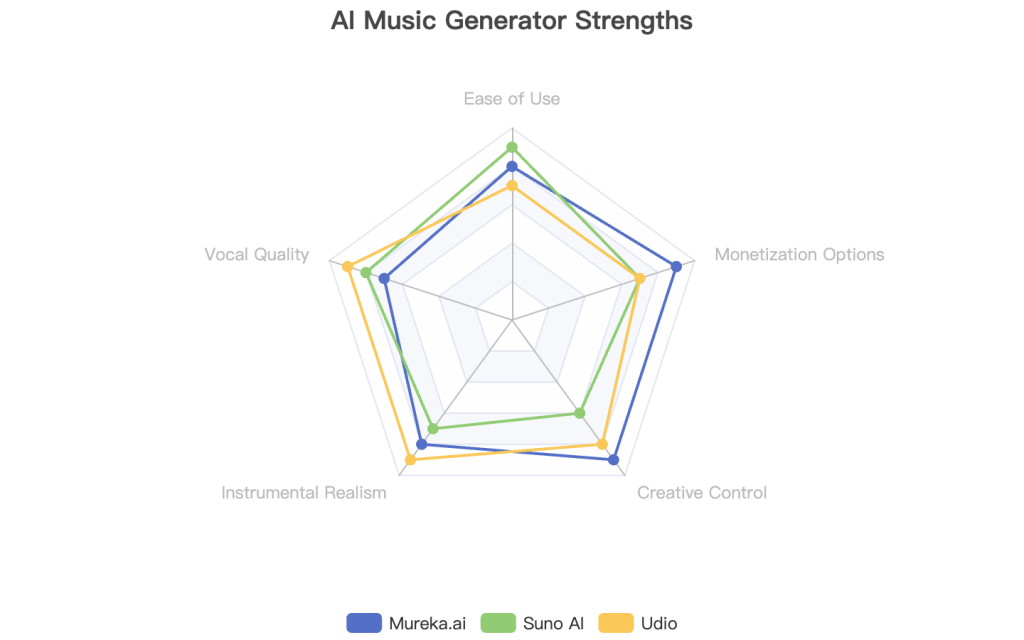
데이터 소스: 플랫폼 테스트 및 공개 리뷰를 기반으로 한 전문가 평가.
Mureka.ai로 음악을 만드는 방법: 단계별 워크플로
이론도 중요하지만 실제로 적용하는 것이 더 중요합니다. 저는 플랫폼에서 몇 시간을 보내면서 간단한 아이디어를 세련된 트랙으로 만드는 데 가장 효과적인 워크플로우를 발견했습니다. 이것은 창의적인 통제력을 유지하면서 Mureka의 강점을 활용하기 위해 고안된 제 개인적인 프로세스입니다.
1단계: 시작 지점 선택
무레카는 여러 가지 창작 경로를 제공합니다. “기본 모드'에서 간단한 텍스트 프롬프트로 시작할 수도 있지만, 저는 ”고급 모드'가 훨씬 더 많은 제어 기능을 제공한다고 생각합니다. 제가 선호하는 시작점은 보통 스타일 참조. 제가 목표로 하는 일반적인 분위기, 템포, 악기 구성이 있는 노래를 YouTube에서 찾습니다. 이렇게 하면 특정 멜로디에 국한되지 않고 AI에 강력한 방향성을 부여할 수 있습니다.
2단계: 초기 세대(고급 모드)
좀 더 복잡한 창작물을 살펴봅시다. 저는 제가 쓴 가사 세트로 시작하여 다음과 같은 태그를 사용하여 가사를 구성했습니다. [구절], [코러스], 및 [다리] 입력 상자에 직접 입력합니다. 스타일은 인디 팝 트랙에 대한 YouTube 링크를 사용했습니다. 그런 다음 “남성 팝 보컬” 프리셋을 선택했습니다. “만들기'를 클릭하자 Mureka는 약 1분 만에 두 개의 전곡 옵션을 생성했습니다. 이 속도는 인상적이었고 빠른 반복이 가능했습니다.
3단계: 편집기에서 검토 및 수정하기
여기서부터 진정한 창작 작업이 시작됩니다. AI가 생성한 첫 번째 버전이 완벽한 경우는 거의 없습니다. 저는 두 트랙을 모두 들어보고 코러스 멜로디가 더 강한 트랙을 선택했습니다. 거기서부터 저는 고급 편집기. 두 번째 구절의 한 줄이 어색하게 느껴져서 그 부분을 선택하고 “재생성”을 눌렀습니다. AI가 흐름에 훨씬 더 잘 맞는 새로운 버전을 제공했습니다. 브릿지가 조금 짧게 느껴져서 “확장” 기능을 사용하여 네 개의 막대를 더 추가했더니 AI가 매끄럽게 작곡해 주었습니다.
4단계: 전문 연마를 위한 스템 내보내기
Mureka의 자동 믹싱 기능도 괜찮지만, 저는 항상 최종 결정권을 갖고 싶어요. 이때 스템 내보내기 기능이 매우 유용합니다. 저는 보컬, 드럼, 베이스, “기타 악기”를 위한 별도의 WAV 파일을 다운로드했습니다. 이 기능은 프로 기능이지만 본격적인 프로덕션에는 필수적인 기능입니다. 이 스템을 제 DAW인 Logic Pro로 직접 가져왔습니다. 여기서 저만의 EQ, 컴프레션, 리버브를 적용하여 자동화된 시스템으로는 완벽하게 재현할 수 없는 전문가 수준의 트랙을 만들 수 있었습니다. 이렇게 AI 생성과 사람의 손길이 어우러져 최고의 결과물을 만들어냅니다.
5단계: 소유권 확정 및 소유권 주장하기
DAW에서 믹스가 완료되면 최종 스테레오 트랙을 내보냈습니다. 다시 Mureka 플랫폼으로 돌아와서 공식 소유권 증명서 를 제출해야 합니다. 이 문서는 특히 음악을 상업적으로 사용하거나 수익 창출 마켓플레이스에 업로드하려는 경우 창작 권리를 증명하는 데 매우 중요합니다.
AI가 만드는 미래: 변화하는 산업에서 Mureka의 역할
Mureka.ai는 진공 상태에서 존재하지 않습니다. 폭발적인 성장을 거듭하고 있는 시장의 핵심 플레이어입니다. 그 가치를 제대로 이해하려면 Mureka.ai가 형성하고 있고 형성되고 있는 광범위한 산업 트렌드를 살펴봐야 합니다.
급성장하는 AI 음악 시장
그 숫자는 놀랍습니다. 의 보고서에 따르면 그랜드 뷰 연구, 에 따르면 2023년 전 세계 음악 시장에서의 제너레이티브 AI는 1조 4,440억 달러로 평가되었습니다. 2030년에는 연평균 성장률(CAGR)이 30.41%에 달해 1조 4,794.7억 달러로 치솟을 것으로 예상됩니다. 현재 북미는 강력한 기술 인프라와 막대한 R&D 투자에 힘입어 2023년 38.6%의 점유율을 차지하며 이 시장을 주도하고 있습니다.
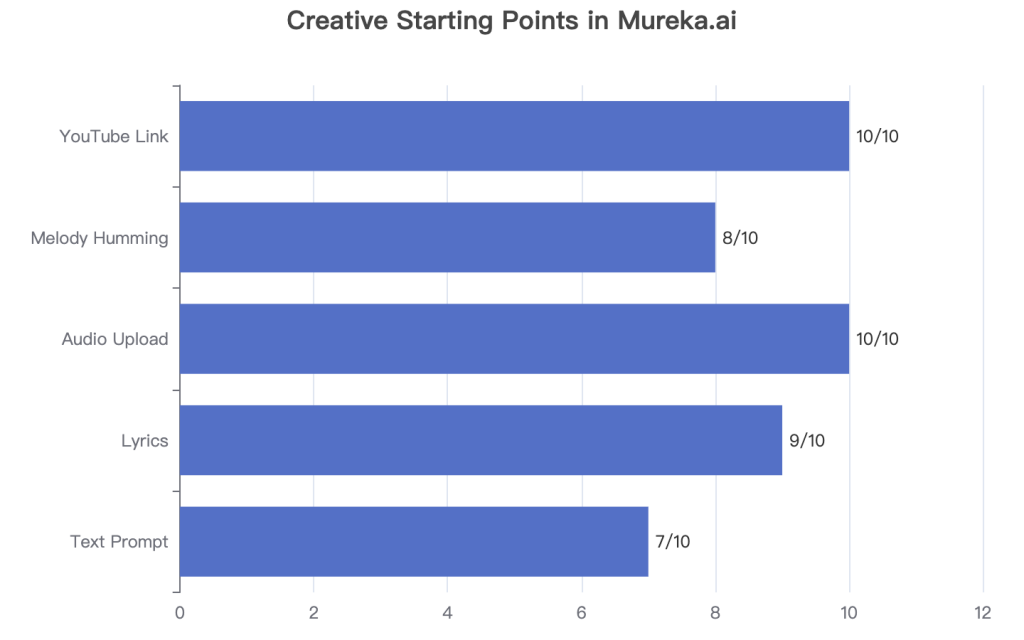
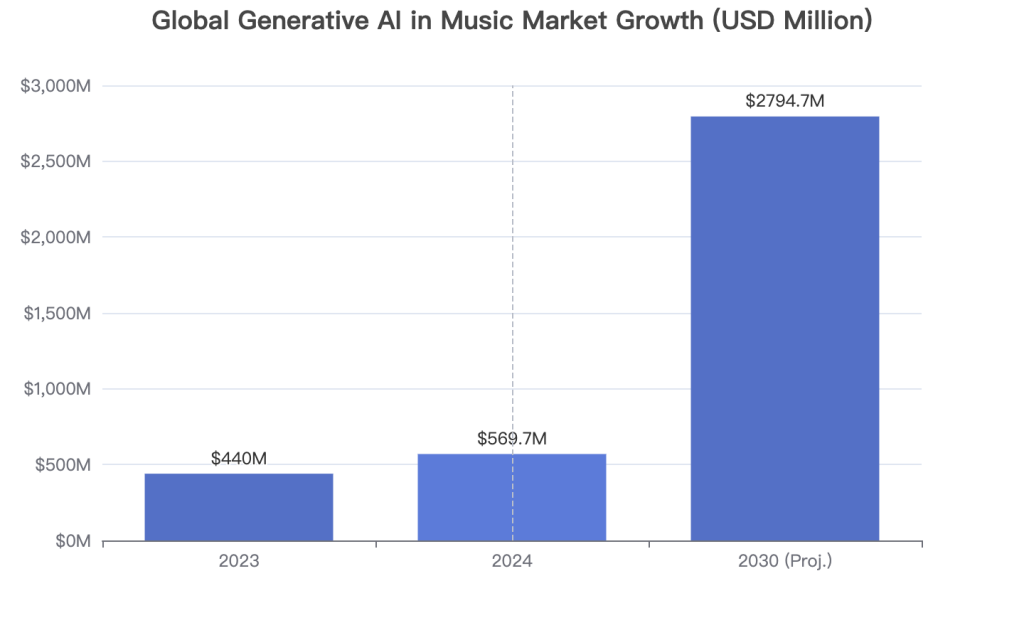
데이터 소스: 그랜드 뷰 리서치, 음악 시장에서의 제너레이티브 AI 보고서(2024-2030년).
무레카의 전략적 포지셔닝
제 분석에 따르면 Mureka는 장기적인 전략을 구사하고 있는 것으로 보입니다. 소비자 대상 도구 외에도 개발자를 위한 강력한 API 플랫폼을 제공하는 B2B 전략에 많은 투자를 하고 있습니다. . 이를 통해 게임, 소셜 미디어, 교육 분야의 기업들은 무레카의 기술을 통합하여 다양한 수익원을 창출할 수 있습니다. 또한, 2025년 중반까지 7번의 주요 업데이트를 거쳐 V7.5에 도달하는 빠른 모델 반복을 지원합니다. -경쟁 분야의 최첨단을 유지하기 위한 치열한 노력을 보여줍니다.
미디어 및 엔터테인먼트에 미치는 광범위한 영향
Mureka와 같은 도구의 부상은 주요 금융 분석가들이 파악한 트렌드와 완벽하게 일치합니다. A 모건 스탠리 리서치 보고서 는 제너레이티브 AI가 일부 미디어 회사의 콘텐츠 제작 비용을 최대 301조 원까지 크게 절감할 수 있다고 강조합니다. 또한 창작을 민주화하여 소규모 업체도 기존 업계에 도전할 수 있게 해줍니다. 주식 연구원 벤자민 스윈번은 “GenAI는 규모 있는 기존 기업과 신규 진입자 모두 사용할 수 있으므로 향후 5년 이내에 개인이 비교적 전문적인 품질의 결과물을 제작할 수 있다고 상상하는 것은 어렵지 않습니다.”라고 말합니다. 이러한 변화로 인해 큐레이션, 개인화, 고유한 라이브 경험의 중요성이 높아지고 있으며, 이러한 영역에서도 AI가 중요한 역할을 할 수 있습니다.
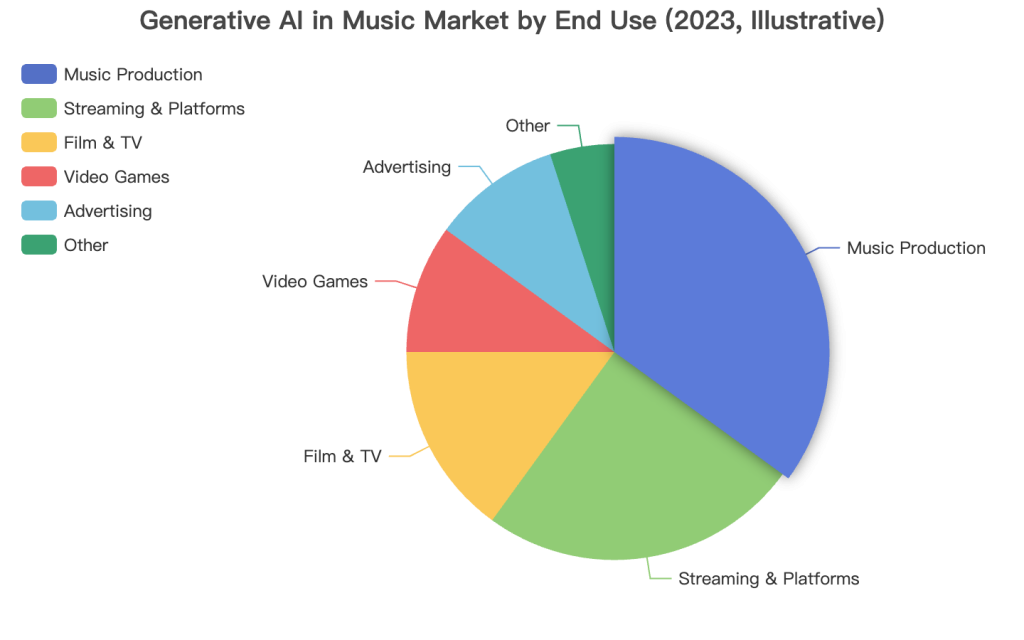
데이터 소스: 최종 사용 범주를 기준으로 한 예시 분석: 다음 출처 그랜드 뷰 연구.
Mureka.ai는 그만한 가치가 있나요? 나의 솔직한 평결 & FAQ
광범위한 테스트와 기능에 대한 심층 분석, 시장 내 맥락화 작업을 거친 후 최종 결론은 무엇일까요? Mureka.ai가 여러분에게 적합한 도구인가요?
제 전문가적 견해로는 Mureka.ai는 놀랍도록 강력하고 다재다능한 “작곡 파트너”입니다. 가사, 멜로디, 분위기 등 특정 아이디어가 있을 때 이를 빠르게 실현 가능한 노래로 바꾸고 싶은 사용자에게 탁월합니다. 다양한 입력 방법과 스템 내보내기 같은 워크플로우 지향적 기능을 통해 AI 생성과 전문 프로덕션 사이의 간극을 메워주는 것이 강점입니다. 단순한 “음악 자판기'라기보다는 협업 도구에 가깝습니다.
그러나 본격적인 DAW를 대체할 수 있는 것은 아니며, 보고된 고객 서비스 및 청구 문제에 주의해야 합니다. 텍스트에서 빠르고 재미있게 노래를 생성하려면 Suno가 더 간단할 수 있습니다. 세밀한 제어가 가능한 절대적인 최고 수준의 오디오 충실도를 원한다면 Udio가 우위에 있을 수 있습니다. 그러나 수익 창출을 위한 직접적인 경로를 포함하는 균형 잡힌 풍부한 기능을 갖춘 플랫폼이라면 Mureka가 매력적인 틈새 시장을 개척하고 있습니다.
장단점 한눈에 보기
| 장점 | 단점 |
|---|---|
| ✅ 다양한 제작 경로(텍스트, 참조, 멜로디) | ❌ 완전한 DAW 대체품이 아닙니다. |
| ✅ 내장된 수익화 마켓플레이스 | ❌ 때때로 일관되지 않은 보컬 품질 |
| ✅ 전문 믹싱을 위한 스템 내보내기 | 보고된 고객 서비스 및 청구 문제(Trustpilot) |
| ✅ 신속한 아이디어 생성 및 프로토타이핑 | 일부 경쟁사에서 제기한 윤리적 투명성 문제 |
| 랩과 같은 특정 장르에서 강력한 성능 제공 | 고급 기능은 유료 구독이 필요합니다. |
자주 묻는 질문(FAQ)
Mureka.ai의 가격 및 요금제는 무엇인가요?
Mureka는 부분 유료화 모델로 운영됩니다. 2025년 말 기준, 가격은 다음과 같이 구성됩니다. 가격은 변동될 수 있으며 최신 정보는 공식 사이트에서 확인하는 것이 가장 좋습니다.
Mureka.ai 요금제 (2025)
| 계획 | 월별 가격(연간 청구) | 노래/월 | 주요 기능 |
|---|---|---|---|
| 기본 | $8 | 400 | 기본 음악 및 음성 생성. |
| Pro | $30 | 1,600 | 고급 기능, 동영상 다운로드, 상업적 사용, 스템 내보내기. |
데이터 소스: Mureka.ai 그리고 FindMyAITool.io. 가격은 다를 수 있습니다.
Mureka.ai의 무료 버전이 있나요?
예. Mureka는 무료 평가판 또는 하루에 제한된 수의 노래를 생성할 수 있는 무료 티어를 제공합니다. 유료 요금제에 가입하기 전에 플랫폼의 기능을 테스트하기에 좋습니다. 그러나 스템 내보내기 및 상업적 사용 권한과 같은 고급 기능은 일반적으로 구독자에게만 제공됩니다.
Mureka.ai의 음악은 로열티가 없나요?
이것은 중요한 포인트입니다. 약관에 따르면 사용자는 일반적으로 자신이 만든 음악의 소유권을 보유하며, 특히 유료 요금제에서는 더욱 그렇습니다. . 이 플랫폼은 “저작권 친화적”으로 설계되었습니다. 그러나 사용 중인 특정 요금제에 대한 서비스 약관을 읽어보는 것이 중요합니다. 상업적 사용의 경우 일반적으로 Pro 요금제가 필요하며, 요금제가 제공하는 소유권 증명서는 사용자의 권리를 주장할 수 있도록 설계되었습니다.
초보자를 위한 Mureka와 Suno의 비교는?
문장을 입력하고 노래를 불러오고 싶은 초보자에게는 Suno의 인터페이스가 더 간단하고 직접적입니다. 하지만 저는 Mureka의 가이드 “고급 모드”가 매우 직관적이라고 생각합니다. 가사나 멜로디를 염두에 두고 있는 경우, Mureka는 이를 통합할 수 있는 명확한 경로를 제공하므로 구체적인 창작 비전을 가진 초보자에게 더 나은 선택입니다.
Mureka.ai로 정말 돈을 벌 수 있나요?
네, 가능합니다. 가장 직접적인 경로는 Mureka에 내장된 마켓플레이스를 통해 트랙 판매를 신청하는 것입니다. 그 외에도 상업용 라이선스가 있는 크리에이터는 스톡 음악 라이브러리에서 음악을 판매하거나, 수익 창출 YouTube 동영상에 사용하거나, 광고 및 기타 프로젝트에 라이선스를 부여할 수 있습니다. 모든 창작 활동과 마찬가지로 성공 여부는 품질, 일관성, 마케팅에 달려 있습니다.

